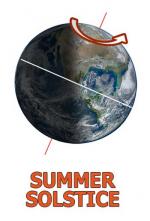The Seasons

This graphic shows Earth with its 23.5° tilt, the direction of its rotation and the pattern of the seasons as it travels around the sun. This is a horizontal perspective facing the equator.
Earth Image Source: NASA
Like the other planets, Earth rotates on its axis as it revolves around the sun. Earth takes 365 and ¼ (6 hours) days to complete one revolution around the sun. To keep our calendars synchronized with the planet's actual orbit, every 4 years we add an extra day to the month of February – 4 quarters of a day (1 quarter each year for 4 years) equals 1 day or 24 hours. When we add a day every 4 years to align the calendar, this year is often called a leap year.
At the present time, Earth is tilted on its axis of rotation by 23.5°. The direction and angle (or tilt) of Earth's axis of rotation do not change as Earth revolves around the sun. Because the direction and angle of the axis of rotation do not change, the Northern Hemisphere is tilted toward the sun during part of the year and away from the sun during another part of the year.

Similar to the previous graphic but this perspective is vertical and looking down at the North Pole.
Earth Image Source: Google Earth
People often mistakenly think that the different seasons are caused by a change in Earth's distance from the sun. This is a misconception because Earth's orbit is only slightly elliptical and our planet is nearly the same distance from the sun all year long. Earth is actually a little farther from the sun when the Northern Hemisphere is having summer. Whichever hemisphere (the Northern or Southern Hemisphere) is tilted toward the sun receives more direct rays of sunlight (or rays that are closer to perpendicular or a 90° angle). The hemisphere tilted toward the sun also has more hours of daylight than the hemisphere that is tilted away from the sun. The combination of more direct rays of sunlight and more hours of daylight causes the hemisphere tilted toward the sun to receive more solar radiation and to have warmer temperatures. When the Northern Hemisphere is tilted toward the sun, latitudes between the equator and 90°N (the North Pole) are experiencing summer. At the same time, the Southern Hemisphere is tilted away from the sun and experiencing winter.
The summer season begins in the Northern Hemisphere on June 20 or 21, known as the summer solstice, when the axis of rotation is tilted a full 23.5° toward the sun. The incoming solar radiation strikes Earth directly at a perpendicular or 90° angle to the 23.5°N parallel of latitude. This 23.5°N parallel of latitude, which runs through Mexico, the Bahamas, Egypt, Saudi Arabia, India, and southern China, is known as the Tropic of Cancer. On the summer solstice, the Northern Hemisphere has the greatest number of daylight hours, whereas the Southern Hemisphere has the fewest. The angle of the sun above Earth's Northern Hemisphere is greatest on this day. Because Earth is tilted toward the sun to the maximum degree, the North Pole has 24 hours of daylight on June 20 or 21, whereas the South Pole (which is tilted away from the sun to the maximum degree) has 24 hours of darkness. After the passing of the summer solstice, the length of daylight in the Northern Hemisphere gradually decreases.
Fall or autumn in the Northern Hemisphere begins September 22 or 23. Remember that the tilt and direction of Earth's axis of rotation is the same as Earth revolves around the sun. On the first day of fall, Earth is neither tilted toward nor away from the sun, causing the length of daylight and nighttime hours to be equal (12 hours) in both hemispheres. This day is often referred to as the fall or autumn equinox. In the Southern Hemisphere, spring begins on this day. Throughout the Northern Hemisphere's fall season, the length of daylight gradually decreases until the first day of winter.
Winter in the Northern Hemisphere begins on December 21 or 22, when the axis of rotation is tilted a full 23.5° away from the sun. On this day, known as the winter solstice, the incoming solar radiation strikes Earth directly at a perpendicular or 90° angle to the 23.5°S parallel of latitude, known as the Tropic of Capricorn. Therefore, the sun's rays strike the Northern Hemisphere at the smallest angle.
On December 21 or 22, the sun appears to be at lowest point on the horizon, and the Northern Hemisphere has the fewest number of daylight hours. In the Southern Hemisphere, this is the day with the greatest number of daylight hours and the beginning of summer. The North Pole has 24 hours of darkness on December 21 or 22, whereas the South Pole has 24 hours of daylight. Throughout the winter season, the length of daylight gradually begins to increase.
Spring in the Northern Hemisphere begins on March 20 or 21 when Earth is again not tilted toward or away from the sun. On this day, known as the spring equinox, there are 12 hours of daylight and 12 hours of darkness in both hemispheres. Fall begins on March 20 or 21 in the Southern Hemisphere. The length of daylight in the Northern Hemisphere continues to increase until the first day of summer.
The University of Nebraska's Seasons Simulator is an interactive animation of the seasons. You can change your latitude and angle of the sun's rays over the course of the year.

Click image to load flash




